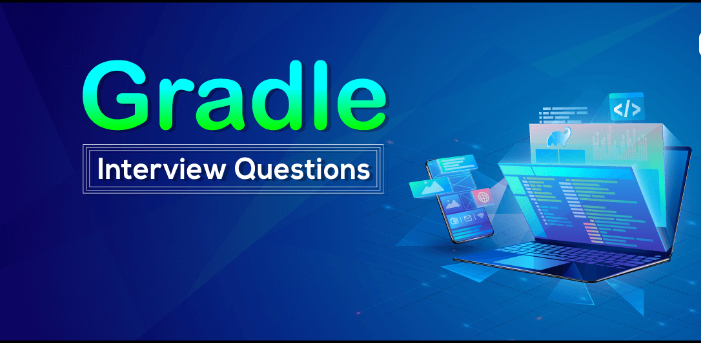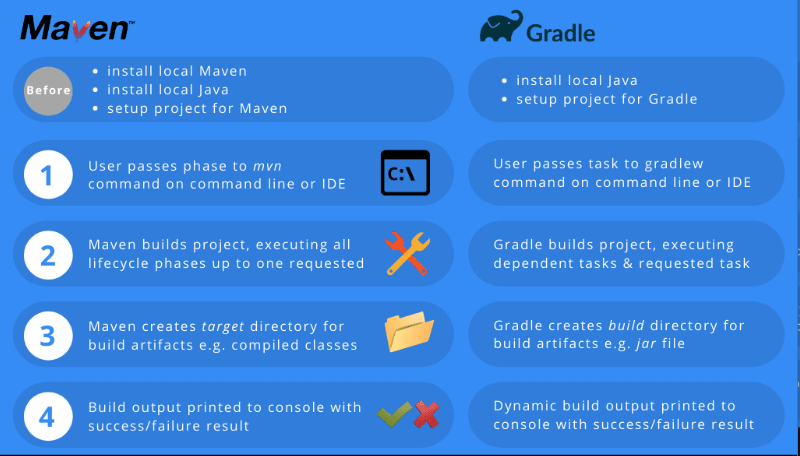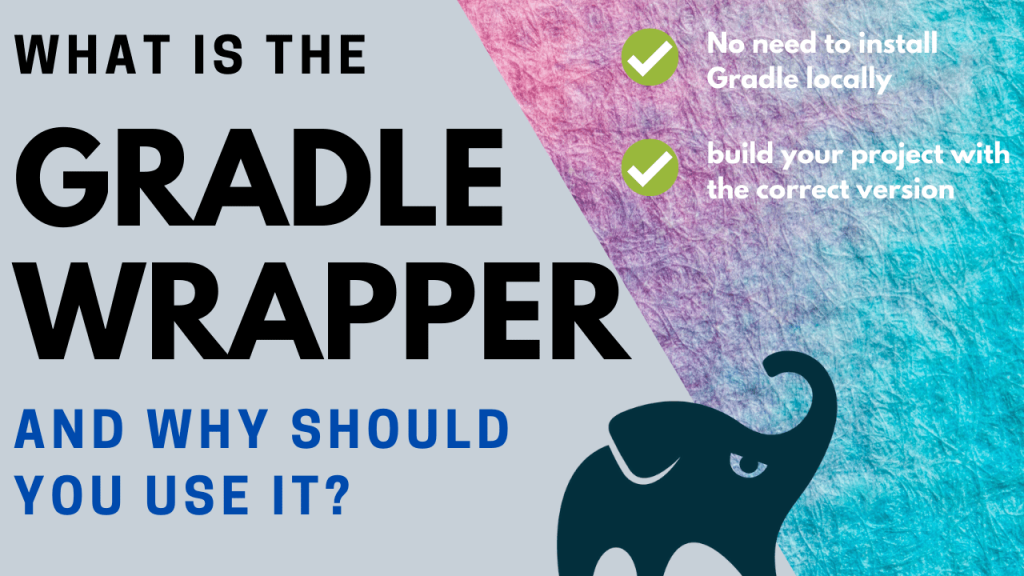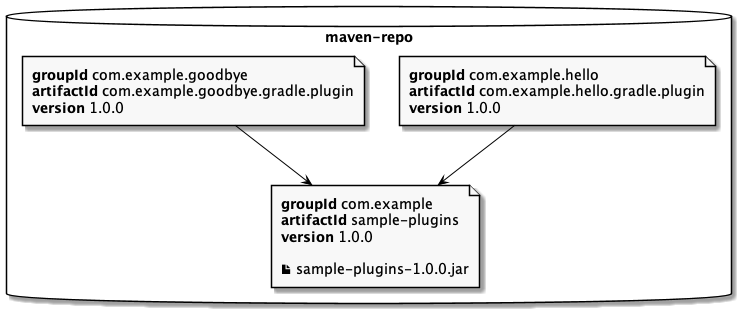
Short description about Gradle
Gradle is an open-source build automation tool that is designed to be flexible enough to build almost any type of software.
Moving to the questions and answers:
1. How can you run Gradle build?
Answer: To run Gradle build, use Gradle command.
2. Can the existing plugins work once you write My build logic in Kotlin?
Answer: Yes, it is quite possible. You can develop the build logic in any JVM language, and the existing plugins would work. It works with each other and with well-written build scripts in Kotlin or Groovy.
3. Mention some advantages of Gradle?
Answer: Gradle is a combination of both Maven and Apache Ant. It takes the best part of these tools like flexibility from Ant and from Maven, plugins, and convention on configuration dependency management.
- It supports all project builds.
- It manages the library in a better way
- It is flexible and configurable.
4. What do you understand by Gradle?
Answer: Gradle is an open-source built system whose main job is to take the project’s resources, source code, and other things related to it into an APK file. Gradle uses a stable programming language known as Groovy rather than using an HTML configuration file.
Gradle build can easily handle anything related to the code of the program as Gradle’s build scripts are coded in a superior language. They are a regular program that uses Groovy instead of Java to write scripts. It also has a directed acyclic graph that determines the task’s order.
5. Explain Gradle Daemon?
Answer: It is a background-built server that you can use to build quickly. Gradle Daemon’s best feature is the fact that its speed becomes faster as you use it more. It is a Java process that acts as a server/client that communicates with a local TCP. It also executes and finds build actions.
6. How can you use Kotlin For Gradle?
Answer: There is no specific way to use Kotlin for Gradle. But JetBrains has come up with IDEA, which is the best solution to use Kotlin for Gradle. Moreover, it works as an inventor driving the force behind Kotlin. It provides the best Kotlin support for Eclipse. Also, Gradle provides means to build the Eclipse logic which improvises the Kotlin after it interacts with Kotlin support for Eclipse.
7. What are the new features of Daemon in Gradle 3.0?
Answer: Daemon has these new updates in Gradle 3.0:
- Enhanced UX
- Resourceful
- Powerful and sturdy
- It is integrated with build scans
- It is by default enabled
8. Explain Groovy?
Answer: Gradle uses a programming language that is written in script form, and the name of that script is Groovy. The features of this language are:
- It interoperates with Java easily as Groovy operates on JVM (Java Virtual Machine).
- To write a build script, you don’t have to learn Groovy.
- It is simple to write and read a Groovy due to its smaller codes than Java.
- It is a dynamic and flexible language that works somewhat similarly to Java. It is also compatible with the byte code of JVM.
9. What do you mean by Gradle Build Task?
Answer: A Gradle Build Task comprises more than one project/task representing the work done with Gradle. For example, it can represent a web application or a library jar or an activity that used Gradle and so on.
Let’s look at the main features of Gradle build tasks:
- Every task has a life-cycle method- do last and do first.
- You can configure the DAG
- Task dependencies are defined using properties like dependsOn, must run after, and so on.
10. Name the language you require to build the Plugin?
Answer: To build a plugin, you require JVM language. But it is recommended that you try various other languages of your choice for building the Gradle plugins.
11. Explain Gradle Wrapper?
Answer: A Gradle Wrapper is a tool that can aid you in running Gradle without having the need for installing or downloading the versions of Gradle you need. The Gradle version you work on with the help of Gradle Wrapper is specific to a particular project only. Gradle wrapper’s key features:
- It is ideal for version control systems and continuous integration servers.
- The scripts of the wrapper download the version of the Gradle you need.
- It configures the wrapper by using wrapper tasks.
- It is suitable for regular Integration Servers
12. . What is Gradle Framework?
Answer: It is a type of automated build system which is open source and creates builds on the concepts of Apache Ant and Maven. It uses a domain-specific language (DSL) which is based on Groovy to declare the configuration of the project. It doesn’t use the XML form that Apache Maven uses for this declaration.
13. Explain Gradle Build Life Cycle?
Answer: The Gradle Build life cycle has three important steps. If you don’t follow these steps, the build cycle will fail. The three steps are the initialization phase, execution phase, and configuration phase.
- Initialization phase: This is the phase where the organization of project layers takes place.
- Configuration phase: This is the phase where you can find the build for current tasks and create a dependency graph for them.
- Execution Phase: The phase where the execution of the end tasks takes place.
Key Features of Graph build life cycle:- During its lifecycle, it can easily receive notifications
- The type of build is determined by settings, Gradle
14. Can you view the available project lists?
Answer: Yes, it is quite possible. With the help of the section- Gradle Projects, you can view the lists of available projects.
15. What is the use of the Gradle Java Plugin?
Answer: A plugin is a source for adding any useful feature to a particular build project like creating documentation and Java code compilation and so on. The Plugin enhances the Gradle features, and it provides an option to customize each and every build.
The main job of a Java Plugin is to add Java compilation besides bundling and testing capabilities to the tasks. The plugin is a SourceSet that acts as a collection of source files that you can execute and compile together. Thus, they add original tasks and can build domino and so on.
16. What are the benefits of working with Gradle?

Answer: The benefit of using Gradle is that you get the best features of both Ant and Maven as Gradle is a combination of both frameworks. It is flexible due to Ant and provides configuration dependency management conversion due to the plugins of Maven.
Other benefits include:
- Best support for various built-up work.
- It can support build for multi-projects.
- Gradle lets you publish the project and attach a library that is self-content and has the best resources and assets.
- Gradle enables the developer to customize and monitor the execution and configuration of the project to its center.
- It is highly scalable. From single build projects to enterprise-level build projects, it lets you build any project with high performance.
17. Explain in detail the reason Gradle is the first choice amongst developers?
Answer: Traditionally, the building was all about packaging and compiling the source code. But now the work of a builder is more than that. They have to perform test runs, merge code resources with multiple sources, provide documentation, manage dependencies and publish applications.
Thus, the builder became software where you can release apps and change tests. And with Gradle, you can perform all these functions in a single place.
For instance, Gradle as the build tool for Android Studio. It makes Gradle more efficient than other tools. In fact, the whole process of building an Android app is now with the Gradle tool. It can work with multiple platforms and has a powerful and compact build language Groovy.
18. Using Groovy for the Build Scripts Deprecated, is it worth the effort?
Answer: No, it is not as the support for Gradle Groovy cannot be deprecated. Instead, it will continue to get the required support.
19. Compare Gradle VS Maven?

Answer: The Java system has two well-known build tools- Gradle and Maven. Both these tools have more similarities than differences, thus it will be interesting to compare these two.
Gradle VS Maven:
What is it: Gradle an open-source build tool is a combination of Maven and Ant. Maven uses Java as its basis to build automation projects.
Language: It works with a domain-specific language with Groovy as its basis. While Apache Maven uses XML for configuring its projects.
Approach: Gradle uses the graph task dependency approach. In this, the tasks are the things that perform the work. Maven uses the approach of a linear and fixed model of phases.
Performance: Performance wise both Gradle and Maven allow multi-projects build. But In Gradle, you can execute only incremental projects. The reason is that it checks for updated tasks and if they are present, there is no execution and the span of build time becomes shorter.
Other functionalities you get with Gradle are:
- Validation of dependency
- Composite Build
- Dependency Rules
- Conflict Revolution
- Java classes compilation
- Java compile avoidance
- Daemon is a compiler that increases the process of compiling.
20. What is the file name built by Gradle?
Answer: Build.gradle is the name of the file name that Gradle builds.
21. Explain Gradle Dependency Management?
Answer: Management of Gradle Dependency includes programming the dependencies that run within the form for building projects in a specific path. It leads to a distinctive syntax that is known as dependencies. The major goal of Gradle is to find a pathway where it can construct or run the tasks so that it can find them.
It also determines the project’s dependencies and highlights them within the build tool. This whole thing is known as Gradle dependency management.
22. Differentiate between build.xml and build.gradle?
Answer: Build.xml is an XML file that has an end and starts tag. Whereas Build.gradle operates on the programming language Groovy.
23. Explain the phrase Gradle Build a Java Project?
Answer: To easily construct a Java Project, you can use a modern tool known as Gradle build file. To do this, firstly add the Java Plugin in the Gradle build script. It will aid in compiling Javadoc, Java-based code, running tests, and build a JAR record. All this will be possible only if you use the “build.gradle” format rightfully throughout the entire process.
24. How can you include Gradle dependencies?
Answer: To add dependencies to a project, state the dependency configuration like the dependencies block of the build.gradle file.
25. Name any three features of Gradle that are advanced?
Answer: The three features are:
- This tool operates as dynamic tasks and a task rule.
- It uses a dependency build script as its base.
- It has a background built-server known as Gradle Daemon
26. What is the process of installing Eclipse Gradle?
Answer: To install Eclipse Gradle, follow these steps:
- Open the Eclipse
- After that, go to the toolbar and select the help menu. Next, ensure that it installs the new software.
- After that click on the section to add it
- Name the section to save it
- After clicking ok, check every checkbox, and after that click on the tab finish section.
27. Which programming language can use Gradle?
Answer: Gradle is a sophisticated and modern tool with unique features and qualities. Many programming languages can use Gradle such as:
- Spock
- Cano
- Groovy
- Hibernate
- Gant
- Spring Integration
- Griffon
- Grails
- FCC
28. Why do developers prefer Gradle over other Frameworks?
Answer: Developers prefer Gradle over other Frameworks because it uses Groovy for scriptwriting which has a similar syntax to Java. It is easy to understand and also offers support for multi-build projects.
29. Explain Gradle Multi-task/project Build?
Answer: Gradle is amongst the best tools that can easily handle multiple projects irrespective of their size. The Gradle tool is a highly effective tool that can work with many kinds of tasks and projects. The work becomes slightly flexible and easy when the file size is small. The name of this complete process is Gradle Multi-project build.
30. What do you mean by Gradle Wrapper?

Answer: The Gradle wrapper is the most suitable way to initiate a Gradle build. A Gradle wrapper is a Windows batch script that has a shell script for the OS (operating system). Once you start the Gradle build via the wrapper, you will see an auto-download that runs the build.
31. Explain the terms Gradle Running a Build?
Answer: One of the unique features of Gradle is that it can work on numerous tasks simultaneously with high-performance quality. The scenario in which Gradle gives a command line to initiate the build script is known as Gradle running build. Thus, it is easy for Gradle to execute numerous project-based work one at a time from within a single build file.
The whole process works as conjunction where you can add or link one project with the other repeatedly.
32. What are the limitations of Gradle?
Answer: There are no known limitations of Gradle, and Gradle is preferred over Maven and Ant. However, in practice, it has been found that IDE integration is not good in Gradle. Secondly, the concept of parent projects that are capable of providing inheritable version numbers doesn’t exist in Gradle.
33. Name Gradle Build Script’s core components?
Answer: The central components of Gradle are Task and Project. Groovy, Gradle’s programming language arranges projects as task lists.
To view the available project’s list-use the Gradle project command. To view that task list, use the Gradle tasks command.
34. What is Dependency Configuration? Explain
Answer: A configuration dependency is a set of dependencies that includes external dependency that you require to install and ensure that the downloading is happening via the web. Some key features of dependency configuration are:
- Compilation: The initial project that you will start and work on should be well-compiled. Also, ensure that you maintain it in good condition.
- Runtime: Runtime is the preferred time that you need to complete the work dependency in a collection form.
- Test Compile: It requires a complete collection for making the project run.
- Test runtime: It’s the final process that requires the checking to complete for running a test which is the default runtime mode.
35. Explain the way through which you can find Gradle Project Dependencies?
Answer: To find Gradle Project dependencies, utilize the command option. It will list selected dependencies that will have both the dependencies- transitive on one side and direct dependencies on the other side.
36. How do you create a build scan in Gradle?
Answer: With the help of a build scan one can develop key insights into what happened during a build, and why it happened. It is more like troubleshooting a failed build with the help of a log file. In order to create a build scan, one needs to run the command “Gradle build –scan”, and can check the output from scan.gradle.com.
37. Differentiate between Build.gradle Script and Maven Build.xml?
Answer: Build.gradle Script operates on Groovy which is the official programming language of Gradle. Also, the build script runs on syntax.
Maven Build.xml has two crucial attributes that define it- end tags and start tags.
38. What are the two types of plugins in Gradle?

Answer: Two types of plugins in Gradle are:
- Script Plugins: This provides the additional build script which gives a declarative approach for manipulating the build, and is typically used within a particular build.
- Binary Plugins: These consist of the classes which are responsible for implementing the plugin interface. It adopts a programmatic approach in order to perform manipulation of the build.
39. What are the steps to create an IntelliJ Idea Gradle Project?
Answer: First, make a new project on IntelliJ. Here you will get various options, select the “Gradle” option from that.
Next, you will see a checkbox that shows the entire empty directories like source test Java or source main Java.
From there, you will select a build wrapper (Gradle) to move on with the project’s process and modify the version of the JVM to 1.8. It will lastly show you the skeletons the project has.
40. Explain The Overall Roadmap?
Answer: With Gradle Script Kotlin, you get a milestone which is then shipped with the 3.0 version. It posts the data pertaining to the roadmap to Kotlin 1.0 Gradle Script.
41. What does the term Gradle Deployment mean?
Answer: It means that you can deploy repositories of build artifacts in various ways. It can use the Maven Publish plugin to readily switch from Gradle to Maven.
42. What version of Gradle is in the market currently?
Answer: The latest version of Gradle automation that is available in the market is 3.5. Released in 2017, it is quick and fast than the previous versions. To know what version of local Gradle you are using, use the –v command.
43. Why choose Gradle over Ant and Maven?
Answer: Ant and Maven are both great tools and have many similar traits and features. Ant is popular for its flexibility while Maven is popular for its management of dependency efficiency.
But the reason why Gradle is the first choice of many people is its unique traits. One of its best features is that it works commendably well on numerous multi-projects with easy-to-use functions. It possesses the key features of both Maven and Ant i.e. convention building and flexibility.
The other two have no support for multi-projects and you have to do a lot of coding.
44. What is Gradle Daemon?
Answer: Gradle Daemon is the background of Gradle that also works as a built server. Gradle Daemon runs at a rapid pace which incidentally is its best part. It has a long-living Java background process. It also operates as a communication solution for a client with the native TCP.
45. Can Gradle work as a migrating agent and how?
Answer: Yes, it can.
By nature, Gradle is very flexible, and that helps it to adapt to any position and structure according to the structure’s behavior. It is a trustworthy source that works step by step efficiently and is not destructive at all.
46. How can Gradle work or perform at a fast pace?
Answer: With the reuse of computation using the previous bud, you can improve the build speed of Gradle. Also, utilizing cache information can also provide better and fast output.
47. What are the core system requirements for installing and running Gradle?
Answer: Gradle can be installed on major platforms, such as MacOS, Windows, and Linux. Since JDK is used for compiling in Gradle, as a prerequisite JDK version 6 or later needs to be installed. There is no specific hardware requirement for Gradle, but a system with 16 GB RAM is considered optimum. Once the Gradle is installed on the system, the environment variables need to be set properly. Gradle build package will not function, without environment variables being set.
48. Explain in detail Gradle Multi-Project Build?
Answer: It is measured as one of the most efficient tools, which can manage any sort of task irrespective of its size. With Gradle, you can competently work with multiple tasks interrelated to projects. If the document is of small size, the task will be a lot easier and flexible. Besides, the whole process is said to be the Gradle Multi-Project building option.
49. Explain Gradle Console, Wrapper, and Daemon?
Answer: The console is the place where all the action happens on the Gradle platform. One can execute the command from the console, check, and print the output, and even check the build status. If there is an error while compiling, it can be checked in Console.
The Gradle wrapper frees the developer from maintaining the version, as it automatically downloads the correct version of Gradle required for a particular build. Gradle wrapper performs this with the help of a script. Gradle daemon is a background process that executes the builds in a quick manner. It remains idle in between when it is not executing the build process, and quietly waits for the next build.
50. Name the configuration files of the Gradle build concept?
Answer: Build.gradle define the script for build configuration
The other script in demand is settings.gradle
Another option is gradle.properties
- Mastering Qualitative Research: The Role of Focus Groups in Data Collection - July 11, 2024
- What is robots ops? - July 10, 2024
- 5 Effective Online Learning Strategies for DevOps Professionals - July 4, 2024

